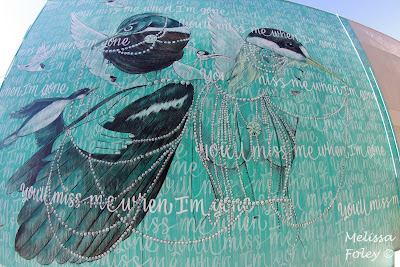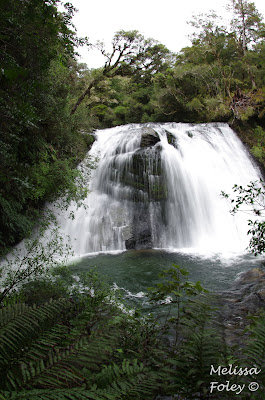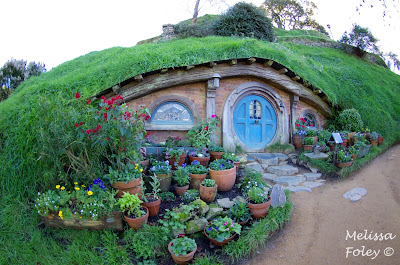A number of months ago I was asked if I would give one of the plenary talks at the New Zealand Marine Sciences Society Conference. I was really honored to be asked and excited about the conference because it was being held in Napier this year, a place neither Pete or I had ever visited. I flew down on a Tuesday to attend the conference and Pete drove down on Friday to join me. We had hoped to make it a long weekend, but field work harkened us back to Auckland a day sooner than we had hoped.
The conference was great, as always. When we arrived in New Zealand last year, I went to the same conference, which was a great way to start my time in the country. A year later, it was a great way to end my time in NZ. There are many familiar faces at this conference, so it was a chance to say "see ya" to many I would not have seen otherwise.
Napier, which sits on Hawke's Bay on the eastern side of the North Island, is an interesting town unlike any other place in NZ. The town was nearly completely destroyed by an earthquake in 1931, which is still NZ's deadliest natural disaster. When the city was rebuilt, they decided to rebuild in the art deco style of the time. It is one of two cities in the world with the best-preserved art deco buildings (South Beach, Miami in Florida is the other).
The other, perhaps less celebrated part of Napier that I loved was her murals. Most of them have an ocean theme and were incredible. I love walking around a town searching for street art and finding hidden gems in unsuspecting places.
After exploring the town, we headed south to Napier's sister city, Hastings, to hike Te Mata peak. The geology of the peak was really interesting and the views of the surrounding wine growing region and mountains were spectacular.
We started our drive back to Auckland the following day. We were trying to get to a friend's house near Whakatane for dinner, so we drove a lot and stopped a little. Although it made for a longer drive, we decided to drive through the heart of Te Urewera. For those of you that have seen The Wilderpeople, the movie was filmed here. (If you haven't seen it, fix that! It is a fantastic film.) Te Urewera used to be a national park but was demoted to simply a protected area at some point in the recent past. It has a very mysterious feel to it but is beautiful. It was a blustery, grey day when we drove through, adding to the feel. Waikeremoana--the large lake that is the centerpiece of the area--was fast changing and wind swept.
We did two short hikes in the park, the first in a grove of tawa trees. The leaves of the tawa trees are a bright yellow-green color, which is quite different than the deep green color of most NZ trees. It also made the forest feel light because the leaves are very thin and numerous. Also along this track is one of the largest northern rata trees in the country. The tree is roughly 1,000 years old, but it didn't start its life on the ground; it started it in the crook of another tree. Rātā trees send down very long roots from their perch that eventually encompass the host tree. The "trunk" of a rātā is not really a trunk at all, but rather a whole bunch of fused roots that form a hollow, psuedo-trunk.
The conference was great, as always. When we arrived in New Zealand last year, I went to the same conference, which was a great way to start my time in the country. A year later, it was a great way to end my time in NZ. There are many familiar faces at this conference, so it was a chance to say "see ya" to many I would not have seen otherwise.
Napier, which sits on Hawke's Bay on the eastern side of the North Island, is an interesting town unlike any other place in NZ. The town was nearly completely destroyed by an earthquake in 1931, which is still NZ's deadliest natural disaster. When the city was rebuilt, they decided to rebuild in the art deco style of the time. It is one of two cities in the world with the best-preserved art deco buildings (South Beach, Miami in Florida is the other).
The other, perhaps less celebrated part of Napier that I loved was her murals. Most of them have an ocean theme and were incredible. I love walking around a town searching for street art and finding hidden gems in unsuspecting places.
We did two short hikes in the park, the first in a grove of tawa trees. The leaves of the tawa trees are a bright yellow-green color, which is quite different than the deep green color of most NZ trees. It also made the forest feel light because the leaves are very thin and numerous. Also along this track is one of the largest northern rata trees in the country. The tree is roughly 1,000 years old, but it didn't start its life on the ground; it started it in the crook of another tree. Rātā trees send down very long roots from their perch that eventually encompass the host tree. The "trunk" of a rātā is not really a trunk at all, but rather a whole bunch of fused roots that form a hollow, psuedo-trunk.
bright leaves of the tawa tree
northern rātā in the middle with its telltale tufty foliage
pseudo-trunk of the rātā - can you see the individual roots?
the trees were singing as they swayed in the strong
wind, adding to the mysterious and magical feel of the place
wind, adding to the mysterious and magical feel of the place
Lake Waikeremoana
Our second hike was to Aniwaniwa Falls, a set of three waterfalls interspersed with tranquil bits of river. I should count, but I'm pretty sure we've seen more waterfalls in our 13 months in NZ than I've seen in my 15 years in California.
The road from Te Urewera back to civilization felt nearly as remote as the reserve itself. There were very small settlements every 10 km or so, horses roamed free, and we hardly saw another soul. We made it to Papamoa in time for a delicious feast with our former coworkers, Ange and Kristy. It was really good to see them and the lives they are building for themselves outside of Auckland. We certainly miss having them on our team, but are happy they are doing well.
Papamoa beach
After a yummy breakfast and a walk on the beach, we started our journey towards Auckland. Our driving time was much shorter than the previous day, so we decided to stop at Wairere Falls, the tallest waterfall on the North Island. The waterfall is in the Kaimai Mamaku Forest Park. Like so many other places in NZ, this forest seemingly materializes out of the gazillion dairy farms in the region.
The hike to the waterfall lookout was beautiful! Given the surrounding paddocks, it was nothing like I expected. There were giant boulders and beautiful, clear streams crisscrossing the track frequently. There were lots of mosses, ferns, and native trees. The 153 m waterfall was pretty spectacular too. We decided to forego the hike to the top based on the weather forecast for high winds and heavy rain. Based on the weather we drove through after our hike, I think we made a good decision.
We drove a lot of kilometers and traversed a lot of landscapes in a weekend. I'll call that another successful Wish trip.
































































































